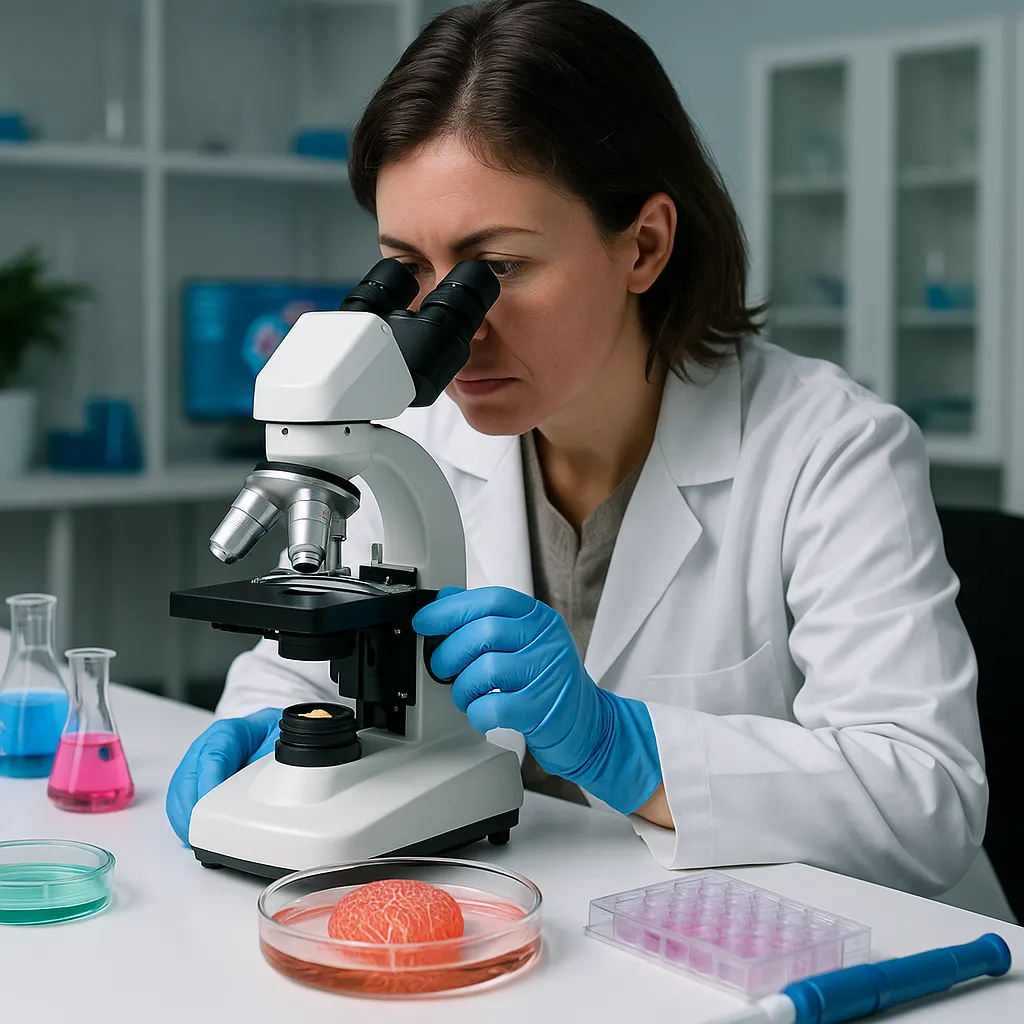Today we share a news that undoubtedly attracts attention and generates illusion, but that also should be taken with some prudence.The researcher Ekaterine Berishvili and her team at the University of Geneva are developing a "cell home", a bio -artificial structure designed to restore natural insulin production in people with type 1 diabetes.
The idea is fascinating: to create a safe environment where to house new Islets of Langerhans, protected from the immune system, which could be implemented under the skin and responsible for producing insulin autonomously.All this avoiding the need for multiple donors and life immunosuppression.
However, although it sounds like a great advance, it is not the first time that we read similar news in the press.Often these projects promise a lot in their initial phases, but then face technical difficulties, lack of financing or simply do not translate into accessible treatments for patients.
From the forum we want to share this news because it is important to know what is being investigated, but we also want to be realistic: for now, insulin remains our only available treatment.
💬 What do you think?
Do you think you are a hopeful advance or think, like many, that these holders generate expectations that are not met?
Would you like to talk more about these issues with a realistic vision, without falling into the "clickbait"?
🧡 And if you have a partner, children or friends who want to better understand what to live with type 1 diabetes, we encourage you to share or give the book "Live with diabetes: the power of the online community."Because science advances, yes, but the support of those around us is what supports us every day.
👉 We read you!
Diabetes Tipo 1 desde 1.998 | FreeStyle Libre 3 | Ypsomed mylife YpsoPump + CamAPS FX | Sin complicaciones. Miembro del equipo de moderación del foro.
Autor de Vivir con Diabetes: El poder de la comunidad online, parte de los ingresos se destinan a financiar el foro de diabetes y mantener la comunidad online activa.
Sígueme en Instagram
Jo, if that could come true, it would be amazing.But it is true that many things of this type come out that then stay at all.In any case, it is fine to know about them.
DM1 desde octubre de 2019 | Toujeo + Fiasp | FreeStyle | febrero 2023: HbA1c 5,9
When I debuted in 86 in addition to all the chaos that it supposed, someone gave me a book on diabetes, in which there were already close solutions or at least talk about the great possibilities that the future would give us in relation to the DM1 ... almost 40 years later, we have heard, read and seen the same hopes ... but we will continue waiting, I would never doubt the people who investigate, I would like to encourage them.
Thanks to everyone who tries to help.
Mi total apoyo a las personas y organizaciones que buscan soluciones✌️
That's what the forum is for, right?To share our doubts, experiences and also advances in diabetes research.
En 1922 descubrieron la insulina, en 1930 la insulina lenta. ¿Que c*** han hecho desde entonces?
Buah, another news."Safe environment where to remove new islets, protected from the immune system, which could be implemented under the skin and responsible for producing insulin autonomously."It is simply an idea without any detail and therefore without meaning, as if saying comes a wizard and heals you with its wand.
When they are in the clinical trial phase in humans, you let me know.If it is not very uncomfortable, I offer myself as a volunteer.
Pd.: And now, if we don't even put the original references, even if they are a press, what do you want me to tell you.I am not going to bother to look for him.
fer said:
@Fer said:
Today we share a news that undoubtedly attracts attention and generates illusion, but that also should be taken with some prudence.The researcher Ekaterine Berishvili and her team at the University of Geneva are developing a "cell home", a bio -artificial structure designed to restore natural insulin production in people with type 1 diabetes.
The idea is fascinating: to create a safe environment where to house new Islets of Langerhans, protected from the immune system, which could be implemented under the skin and responsible for producing insulin autonomously.All this avoiding the need for multiple donors and life immunosuppression.
However, although it sounds like a great advance, it is not the first time that we read similar news in the press.Often these projects promise a lot in their initial phases, but then face technical difficulties, lack of financing or simply do not translate into accessible treatments for patients.
From the forum we want to share this news because it is important to know what is being investigated, but we also want to be realistic: for now, insulin remains our only available treatment.
💬 What do you think?
Do you think you are a hopeful advance or think, like many, that these holders generate expectations that are not met?
Would you like to talk more about these issues with a realistic vision, without falling into the "clickbait"?
🧡 And if you have a partner, children or friends who want to better understand what to live with type 1 diabetes, we encourage you to share or give the book "Live with diabetes: the power of the online community."Because science advances, yes, but the support of those around us is what supports us every day.
👉 We read you!
No signature configured, add it on your user's profile.
I have worked for many years in research, specifically in microencapsulation, among other issues.I remember that in the 90s an experience of microencapsular cells was already made in Australia, so that the size of the pores allowed the entry and exit of liquids and molecules, but not that of antibodies and other entities of the immune system that attack the cell.I remember reading the article in which it was reported that a man with DM1 had been implemented and for 1 year the follow -up had been done and was Normaglucent during all that time, without taking anything.There were no more articles.What happened?mystery.That is, the issue is not new and I have always considered that this is the only way, but it also leaves out billions in drugs and that, well you know.
We still know why the immune system attacks those cells and this is the heart of the topic, another route of research to follow.The problem is that no pharmaceutical company will follow these lines (such as Alzehimer and anti -inflammatories).
No signature configured, add it on your user's profile.
PeterNut said:
@Peternut said:
I have worked for many years in research, specifically in microencapsulation, among other issues.I remember that in the 90s an experience of microencapsular cells was already made in Australia, so that the size of the pores allowed the entry and exit of liquids and molecules, but not that of antibodies and other entities of the immune system that attack the cell.I remember reading the article in which it was reported that a man with DM1 had been implemented and for 1 year the follow -up had been done and was Normaglucent during all that time, without taking anything.There were no more articles.What happened?mystery.That is, the issue is not new and I have always considered that this is the only way, but it also leaves out billions in drugs and that, well you know.
We still know why the immune system attacks those cells and this is the heart of the topic, another route of research to follow.The problem is that no pharmaceutical company will follow those lines.
The man who was put the islets and worked for him, took immunosuppression for an anterior transplant, so he surely didn't even carry the encapsulated in the islets.
The encapsulated cells were put to mice.Then they mixed the two news as they always do, to make believe that encapsulated cells worked in humans.Thing have never done.Beta cells encapsulated, die due to lack of oxygen in humans.
In mice instead having much more metabolism survive.
En 1922 descubrieron la insulina, en 1930 la insulina lenta. ¿Que c*** han hecho desde entonces?
You make comments that are not so.The patient I have referred to, of which you have surely not read the article, did not come from any transplant and of course it took the encapsulated beta cells for a minimum of one year (the islets are a large structures, they do not encapsulate) I am talking about an article published by the authors of a scientific magazine, so there is no confusion, or mice through in between.I don't know why you talk about things you have not read.In any case it will be other cases, but the one who quotes is exactly like that.
I will add that dozens are the tests that have been done and are being made of microencapsulated beta cells, it is no novelty.None has gone to clinical trial phase 3.
No signature configured, add it on your user's profile.
PeterNut said:
@Peternut said:
You make comments that are not so.The patient I have referred to, of which you have surely not read the article, did not come from any transplant and of course it took the encapsulated beta cells for a minimum of one year (the islets are a large structures, they do not encapsulate) I am talking about an article published by the authors of a scientific magazine, so there is no confusion, or mice through in between.I don't know why you talk about things you have not read.In any case it will be other cases, but the one who quotes is exactly like that.
I will add that dozens are the tests that have been done and are being made of microencapsulated beta cells, it is no novelty.None has gone to clinical trial phase 3.
I read all the news that comes out in Spain and all those of encapsulated are usually like that.They put the capsules to mice and loose cells to immuno-depressed humans, to be able to mix the news and seem what it is not.
They do it since the 1990s with the companyVivorx,The famous Chinese doctor Soon Shiong and the patient Stephen Craig.The doctor ended up a billionaire and the suicide patient.Until today all the investigations I have seen have done the same.
It is possible that some have not been so, but at least in the Spanish media it has not transcended.
If you give any source or something we can find out more.
But the capsules have the problem that do not oxygenate well, there were even some that you had to recharge them of oxygen continuously but it was very little practical.
En 1922 descubrieron la insulina, en 1930 la insulina lenta. ¿Que c*** han hecho desde entonces?
This news is aimed at naive investors who believe any news.
They get funds and then the company disappears.
If it were something with feet and head, it would be announced in phases of final development, when they have already demonstrated effectiveness and are about to get it to the market, not in the first two weeks to ask for money.
Hijo con 6 años con DM1. Novorrapid, Lantus, FreeStyle.
All this is summarized in,
Damn Parné !!!
Diabetics are premium clients.
What company, organization, etc., will lose some customers for life.It is best to get the advances slowly and keep living patients the maximum time/spending.
I still don't believe that we have human insulin.
No signature configured, add it on your user's profile.







